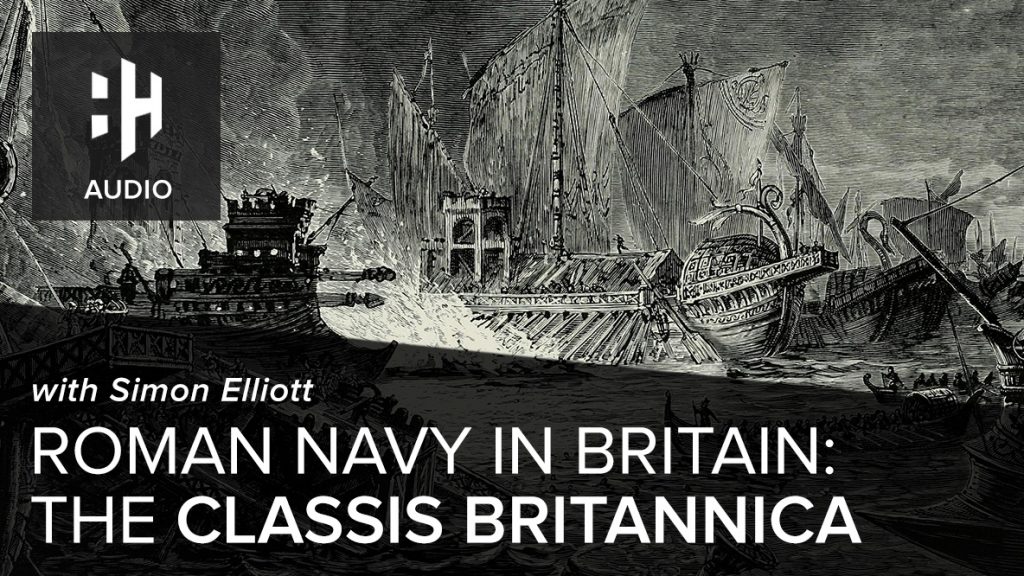Image: A mosaic of a Roman galley from the 2nd century, displayed at the Bardo Museum in Tunisia.
This article is an edited transcript of Roman Navy in Britain: The Classis Britannica with Simon Elliott available on History Hit TV.
 Listen Now
Listen NowThe Classis Britannica was the Roman fleet in Britain. It was created from the 900 ships built for the Claudian invasion in the year 43 AD and staffed by about 7,000 personnel. It remained in existence until the mid-3rd century, when it mysteriously disappears from the historical record.
This disappearance might have been due to the Crisis of the Third Century. From the assassination of Alexander Severus in 235 through to the accession of Diocletian in 284, there was a lot of turmoil – both political and economic – in the Roman empire, and particularly in its West.
There was a weakening of Roman strength, which people north of the borders – in Germany, for instance – could exploit. You also often find with economic superpowers that there is a flow of wealth across their borders, which changes the political structure on the other side of the border.
There tends to be a pattern where there are initially a lot of small political organisations on the other side of the border, but where, over time, certain leaders gradually amass wealth, which leads to a coalescence of power and bigger and bigger political units.
The fleet remained in existence until the mid-3rd century, when it mysteriously disappears from the historical record.
Indeed, big confederations began creating friction along the Roman empire’s northern border from the middle of the 3rd century onwards.
The Saxon raiders had their own maritime technology, and they would have discovered the existence of the wealthy province of Britain – especially its southern and eastern parts – where there were opportunities for them. There was then a coalescence of power and the raiding started.
 Watch Now
Watch NowPulled apart from within
There was also internal Roman conflict, which undermined the fleet’s capacity.
In 260, Postumus initiated his Gallic Empire, pulling Britain and northwestern Europe away from the central empire for up to 10 years. Then, the pirate king Carausius created his North Sea Empire from 286 to 296.
Carausius was initially brought in by the Roman emperor as an experienced naval warrior, to clear the North Sea of pirates. This shows that the Classis Britannica had disappeared by that time as it was no longer handling raids by Saxon pirates.
He was then accused by the emperor of pocketing the wealth from these raiders, who he had successfully driven out of the North Sea. So Carausius created his own North Sea Empire out of northwestern Gaul and Britain.
The last reference we have to the Classis Britannica is in 249. At some stage between 249 and the accession of Carausius, we know that there was endemic raiding in the North Sea – and therefore that there was no fleet in Britain.
Therein lies the great mystery.

A surviving remnant of the Roman Wall at Tower Hill. In front stands a replica of a statue of Emperor Trajan. Credit: Gene.arboit / Commons.
The missing navy
There are a number of potential reasons for the fleet’s disappearance. One could be money-related because the Roman military was becoming increasingly expensive to run at a time of economic crisis.
But the fleet more likely fell foul of usurpation somehow. It could have backed the wrong people politically and, with the turmoil of the 3rd-century crisis, been swiftly punished by the winner.
Specifically, there was the Gallic Empire, during which time a series of Gallic emperors usurped each other, before, within a decade, the empire was brought back into the fold by the Roman Empire in the West.
So at any stage the prefectus of the Classis Britannica could have backed the wrong horse and the fleet might have been punished by being disbanded.
But the fleet more likely fell foul of usurpation somehow.
Once such capability is lost, it’s quite hard to just reimagine it again. You can invent legions quite quickly, but what you can’t do is will into being a maritime force. You need logistics, boat yards, skilled craftsmen, labourers and wood that has been properly treated and left to be prepared – all of which takes decades.
As the British admiral John Cunningham effectively said during World War Two when he was offered the opportunity of withdrawing the Royal Navy and evacuating troops to Egypt, “It takes three years to build a ship, but 300 years to build a reputation, so we fight on”.
 Watch Now
Watch NowLife without a fleet
Britain was one of the farthest places you could go in the Roman Empire from Rome, the centre of political power; it was always a frontier zone.
Meanwhile, the northern and western parts of the empire were always militarised border zones. Although these areas became provinces, they weren’t the same as the southern and eastern territories which were fully functioning units of the empire.
“It takes three years to build a ship, but 300 years to build a reputation, so we fight on.”
If you were an aristocrat who wanted to make their name fighting, you would go either to the northern border in Britain or to the Persian frontier. Britain genuinely was the Wild West of the Roman Empire.
The growth in the number of Saxon Shore (military command of the late Roman Empire) forts is actually a sign of a weakness within Britain’s naval power at that time. You only build forts on the land if you can’t stop people getting to your coastline at sea.
If you look at some of the forts, for example the Saxon Shore fort at Dover, they are built on top of earlier Classis Britannica forts. But although there were some Classis Britannica forts, they were very much aligned with the actual fleet as opposed to being these huge structures.
If you go to somewhere like Richborough you can see the scale of some of these Saxon Shore forts, which demonstrates the intense investment from the Roman state to build these things.
Britain genuinely was the Wild West of the Roman Empire.
We do know that the Romans were using naval forces, at least according to the written record, if nothing else. For example, in the 360s Emperor Julian built 700 ships in Britain and Gaul to help take grain from Britain to his army on the Rhine, which was fighting in the Battle of Strasbourg.

A map showing fortifications within the Saxon Shore system in around 380 AD.
But that wasn’t the integral, fully functioning navy that the Romans had in Britain until the mid-3rd century – it was a one-off event. A fleet is constructed to do a specific thing.
After the Classis Britannica, the Romans may have had local coastal forces dotted around here and there, but not the homogeneous 7,000-man and 900-ship navy that had existed for 200 years of the empire’s rule.
Now, however you define what the Saxons were – whether they were raiders or whether they were being brought over as mercenaries – they were coming to Britain and that does indicate, in some way, shape or form, that control of the North Sea had been lost towards the end of the empire.
But it wasn’t the integral, fully functioning navy that the Romans had in Britain until the mid-3rd century – it was a one-off event.
We even know that there was a great invasion where a number of the empire’s opponents from north of the border, from Ireland and Germany, hit the north of the province, in the 360s or maybe a little later.
And we know for a fact that it was one of the first times that an invasion force sent troops by sea around Hadrian’s Wall to get to the north-east coast. That would never have happened with the Classis Britannica in existence.















